ENDOCRINE SYSTEM Endorine system and nervous system are
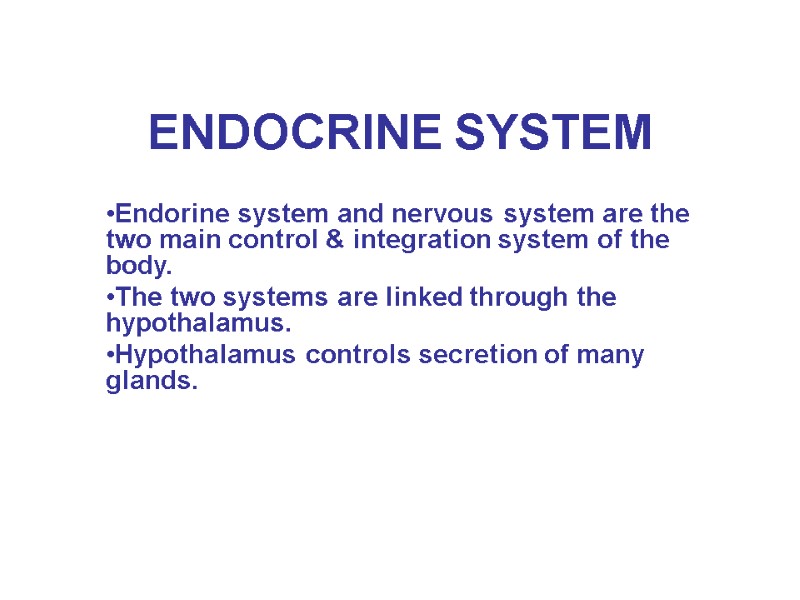
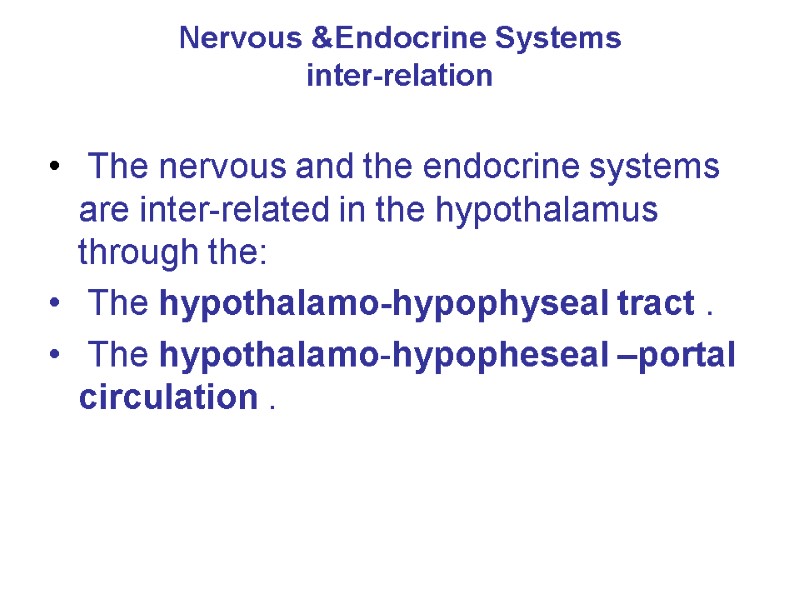
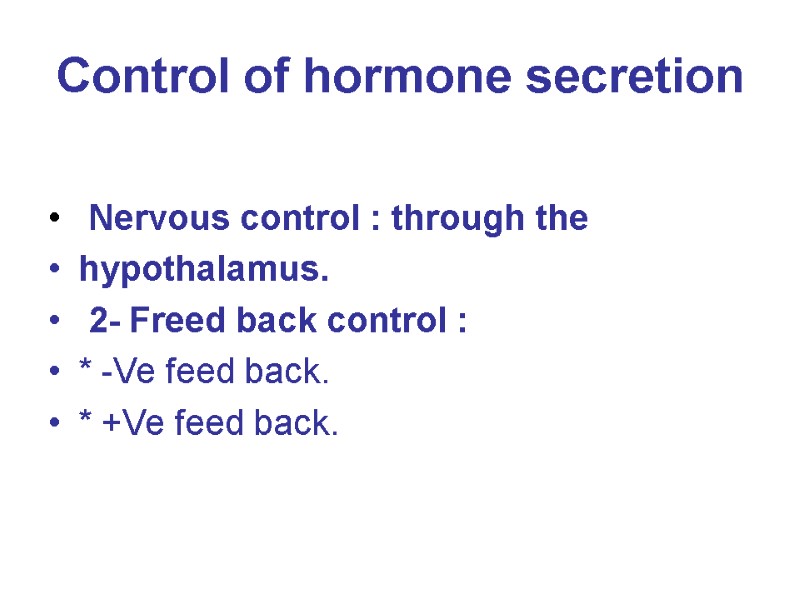
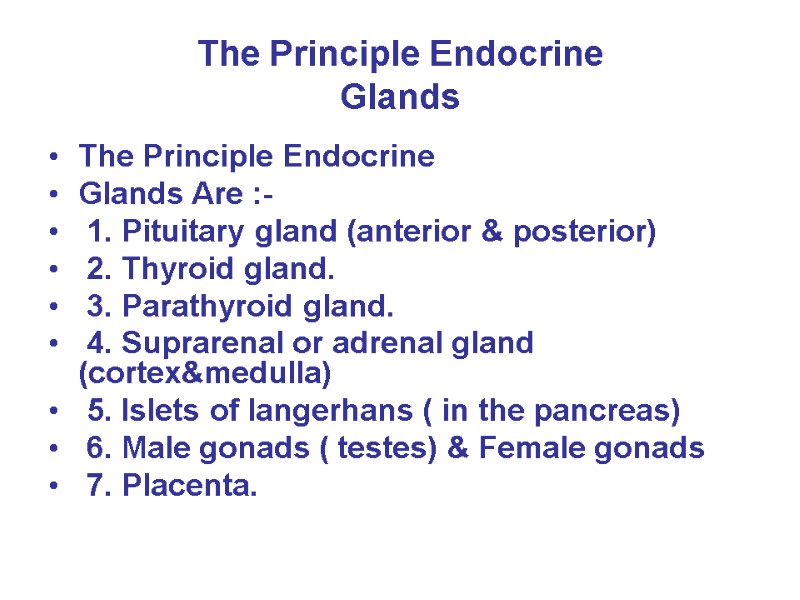
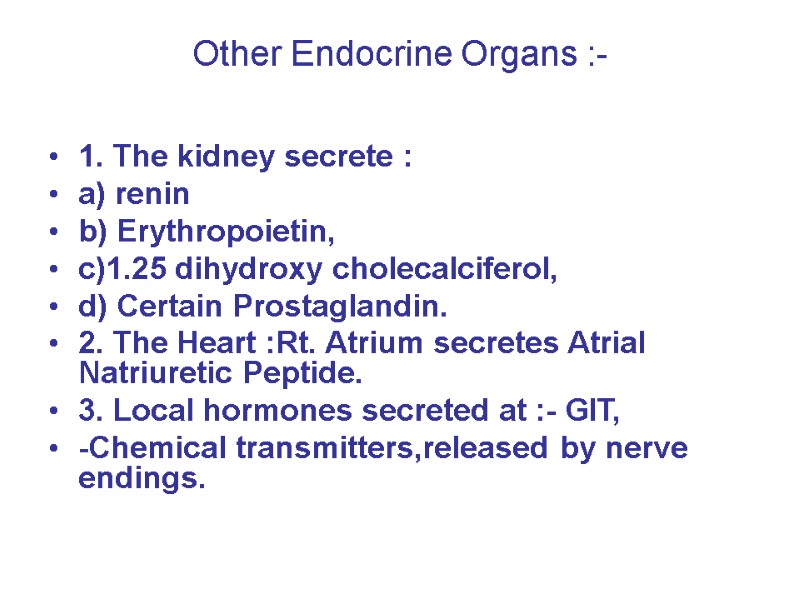
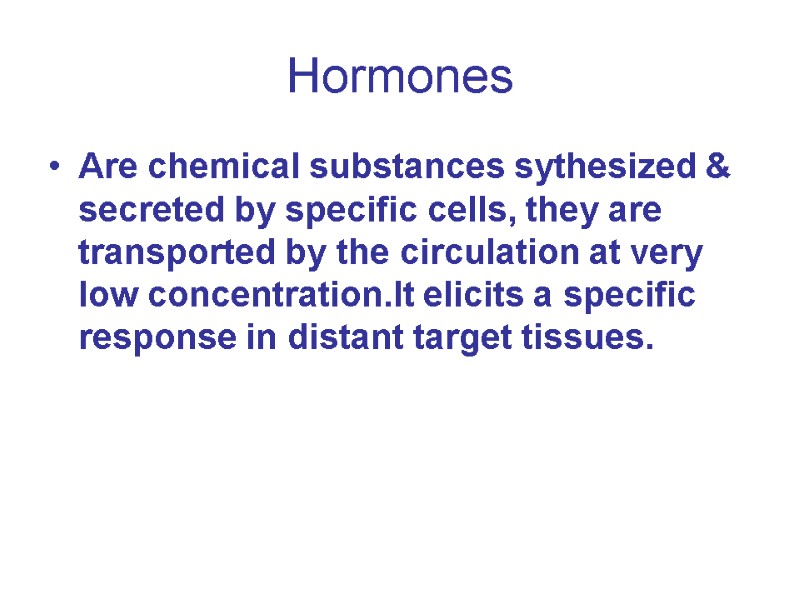
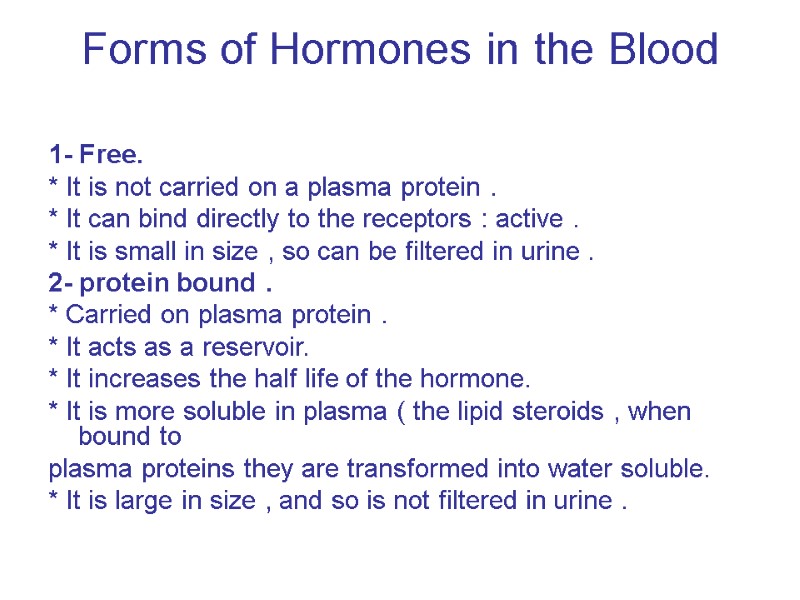
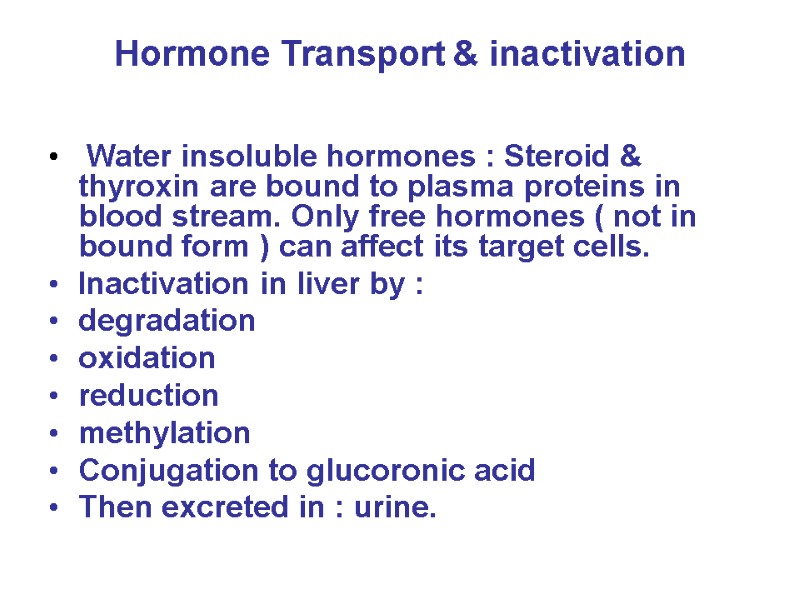
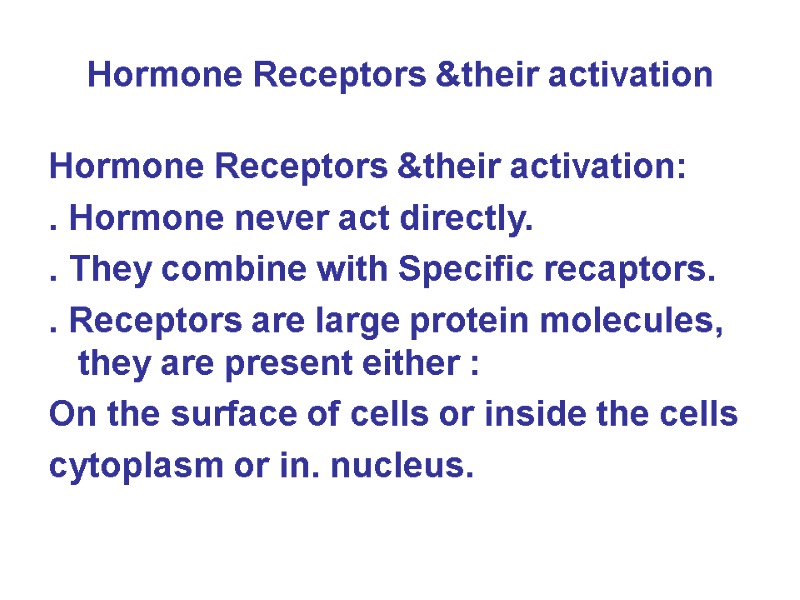
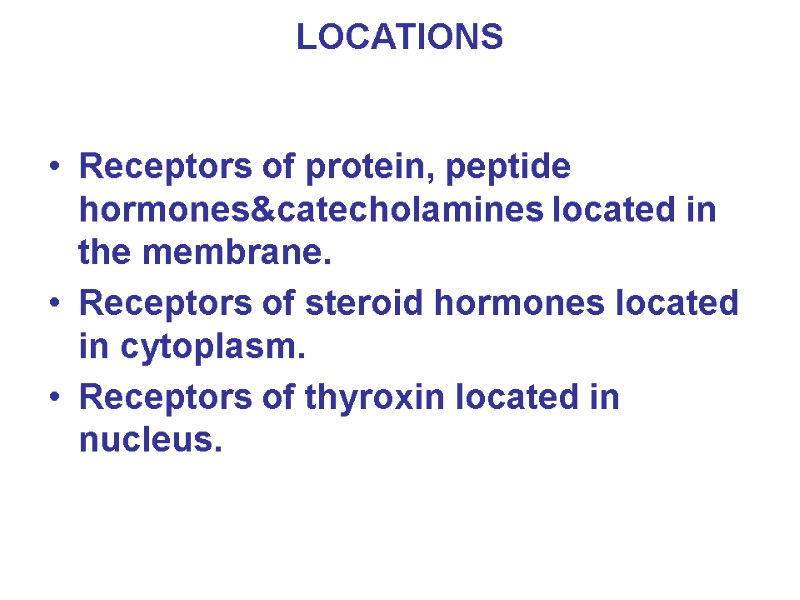
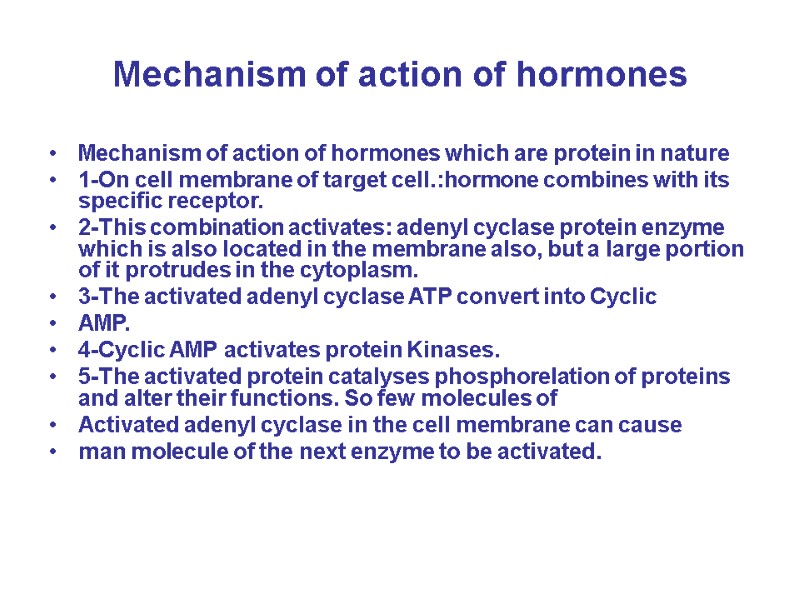
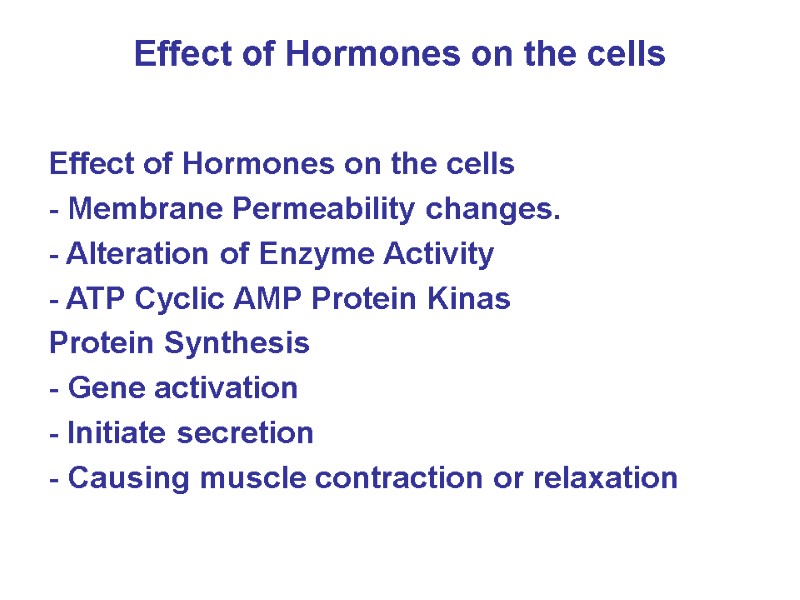
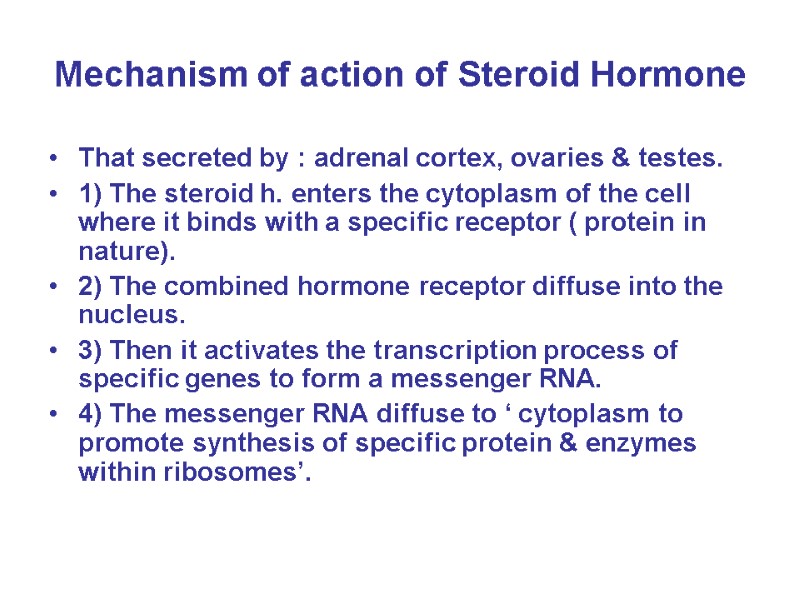
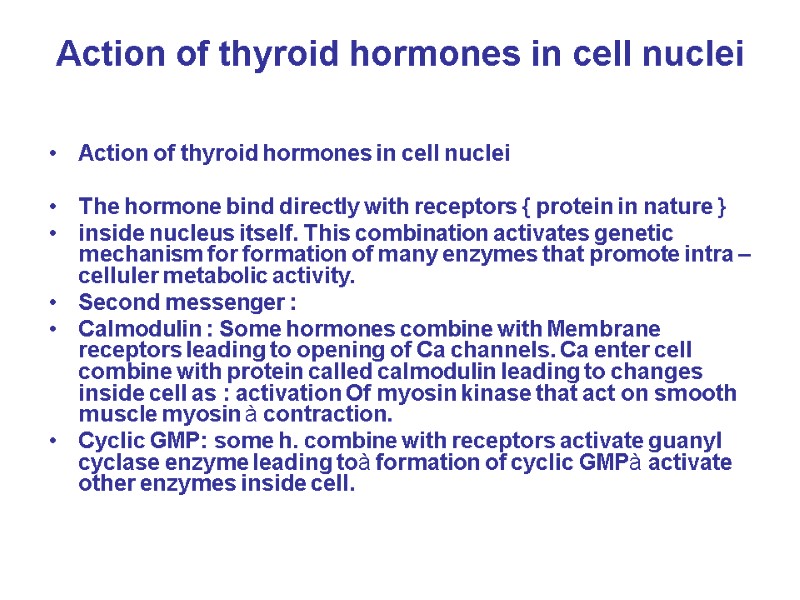
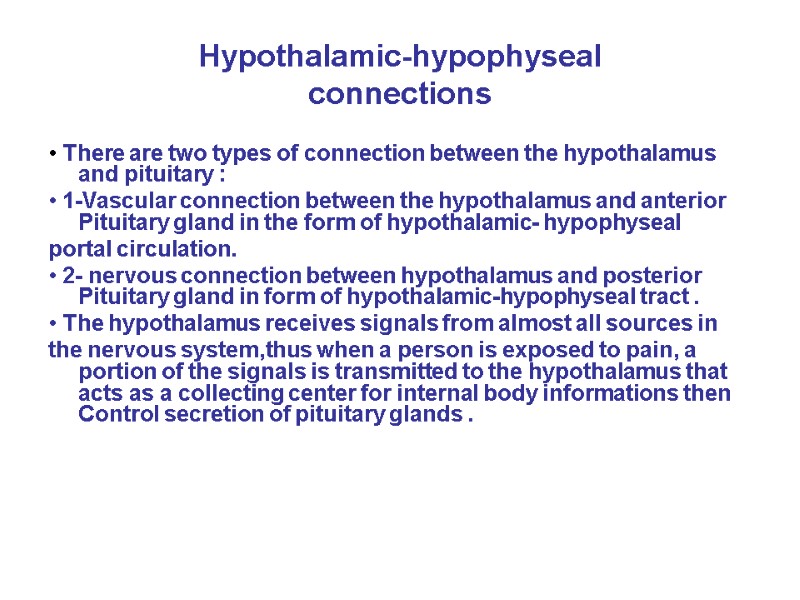
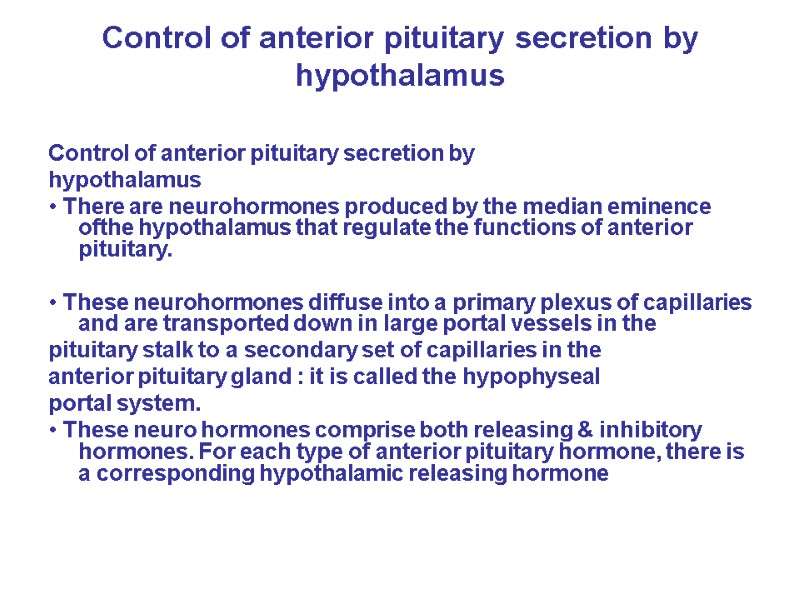
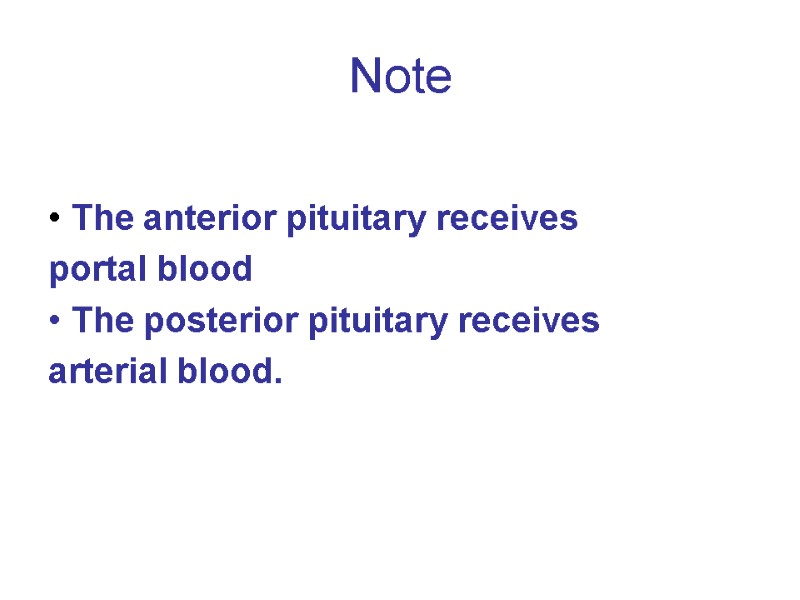
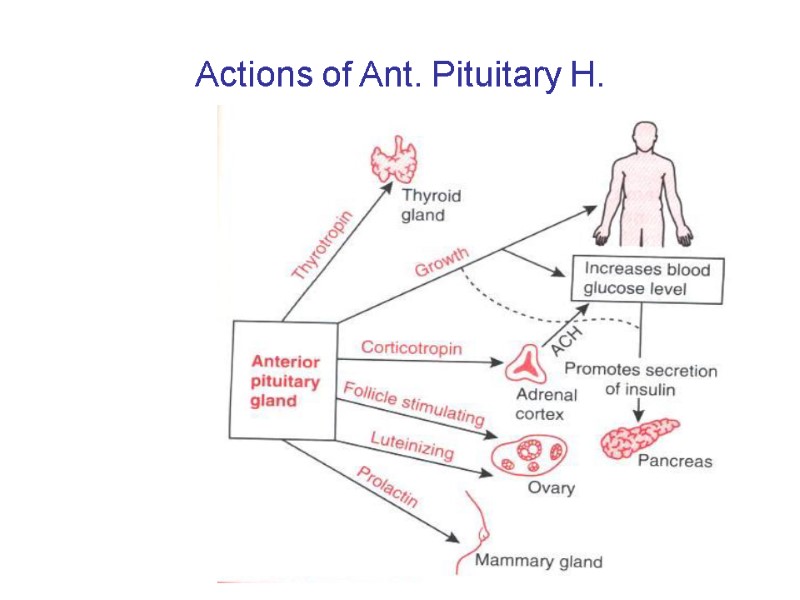
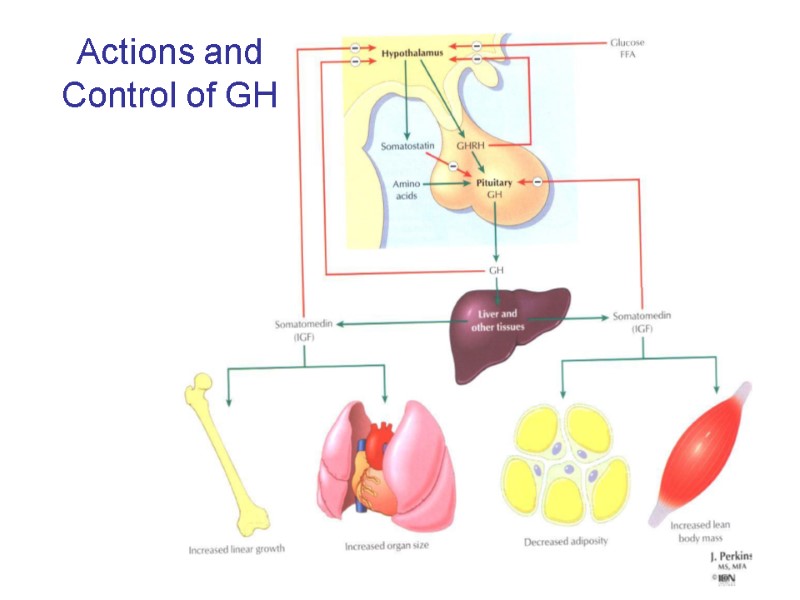
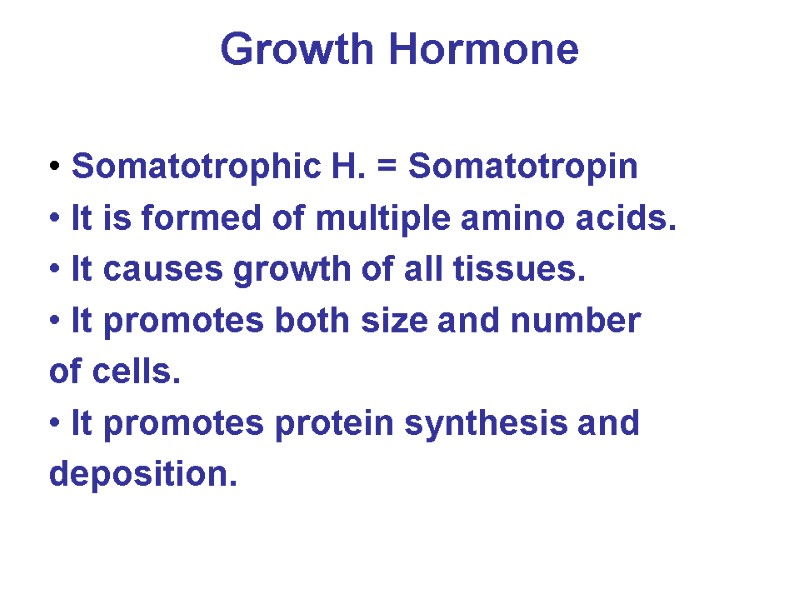
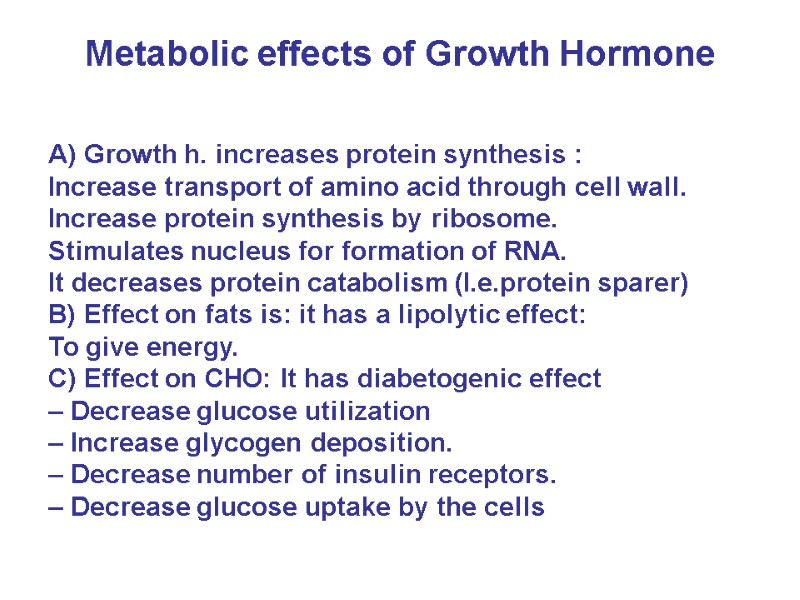
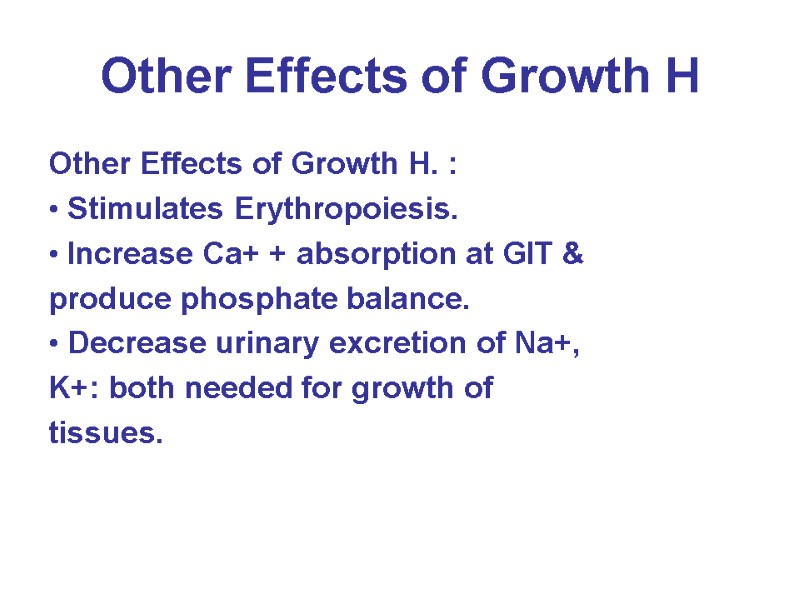
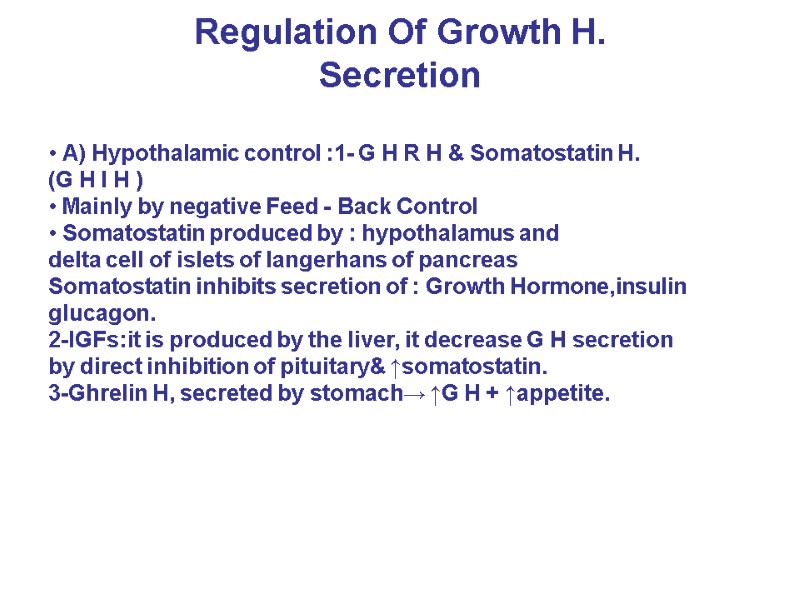
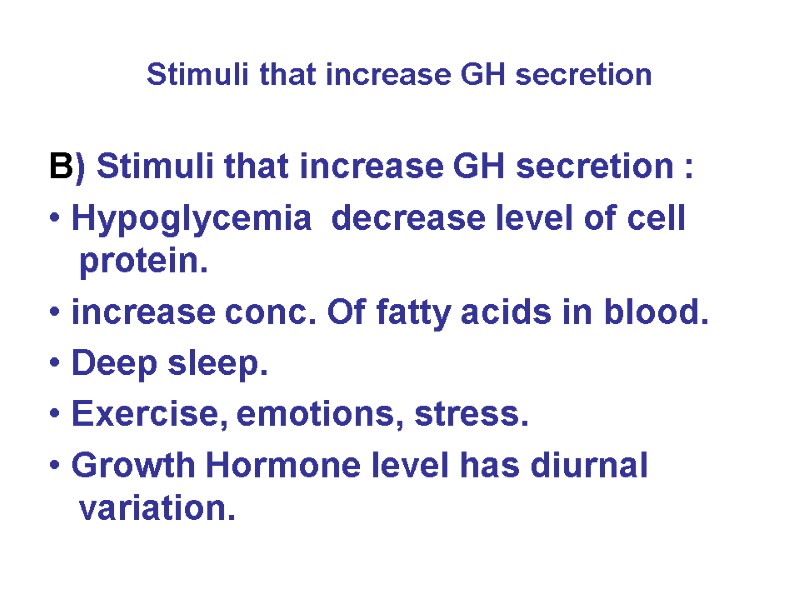
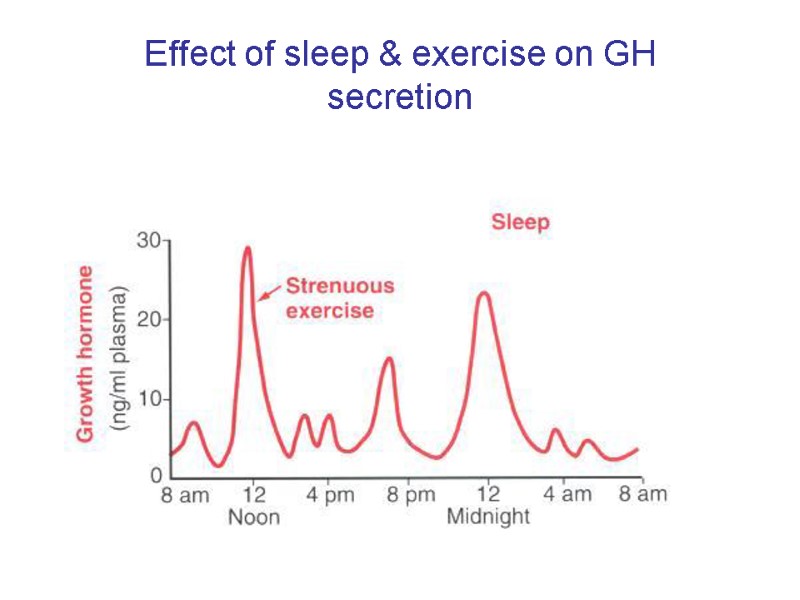
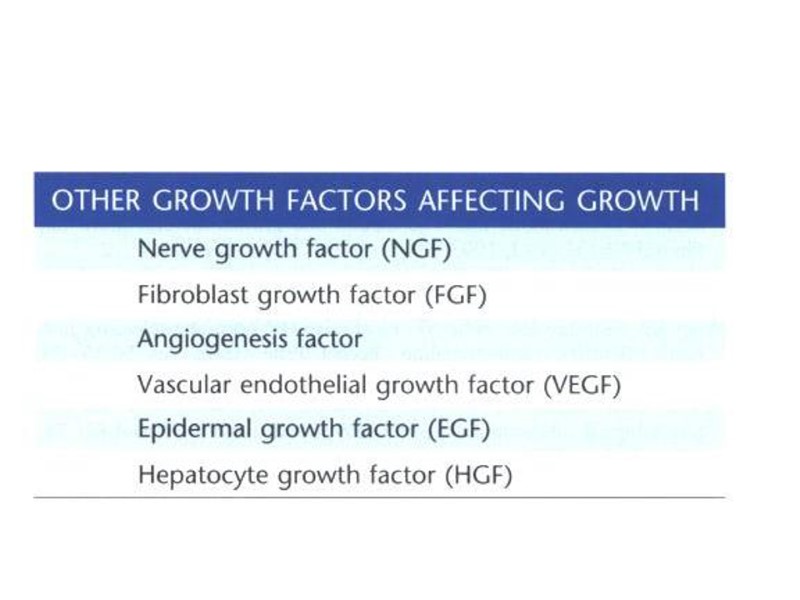
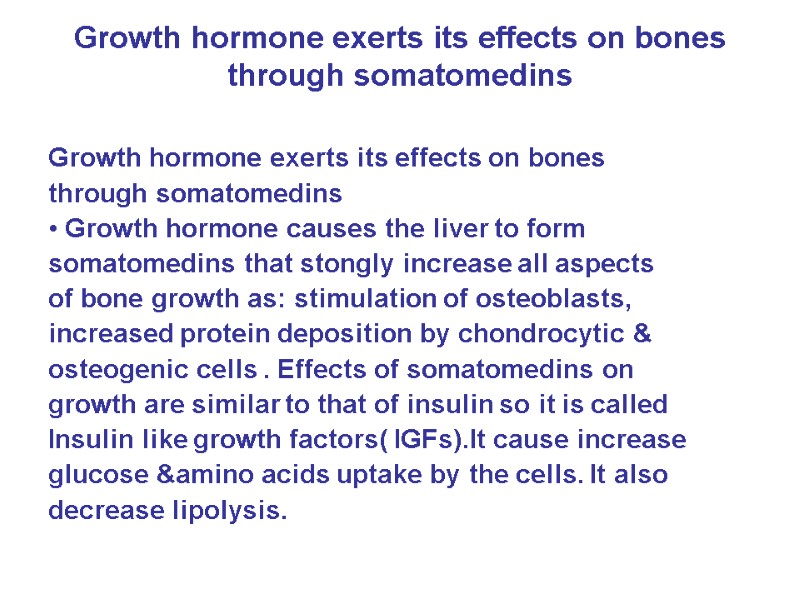
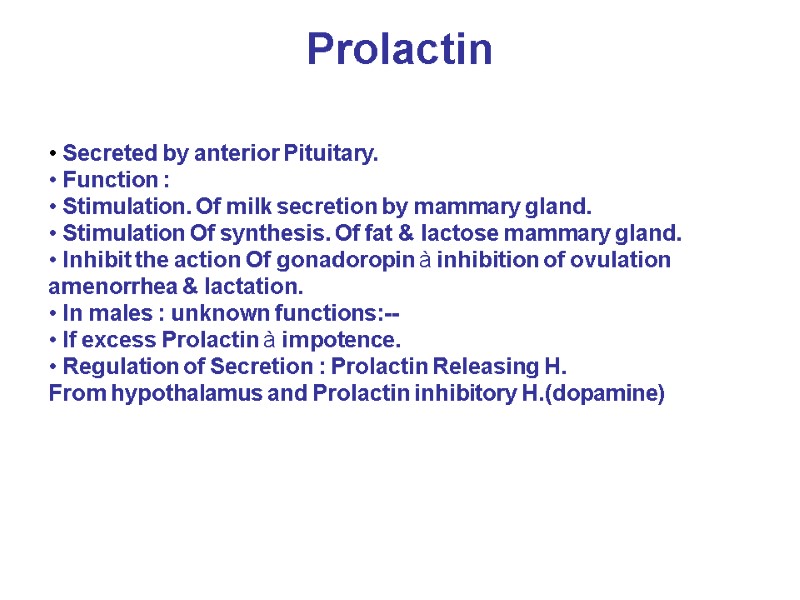
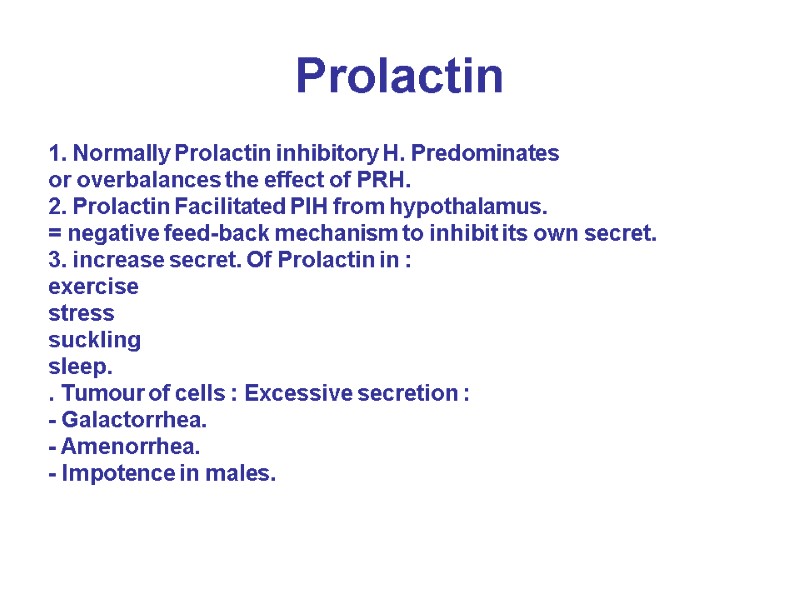
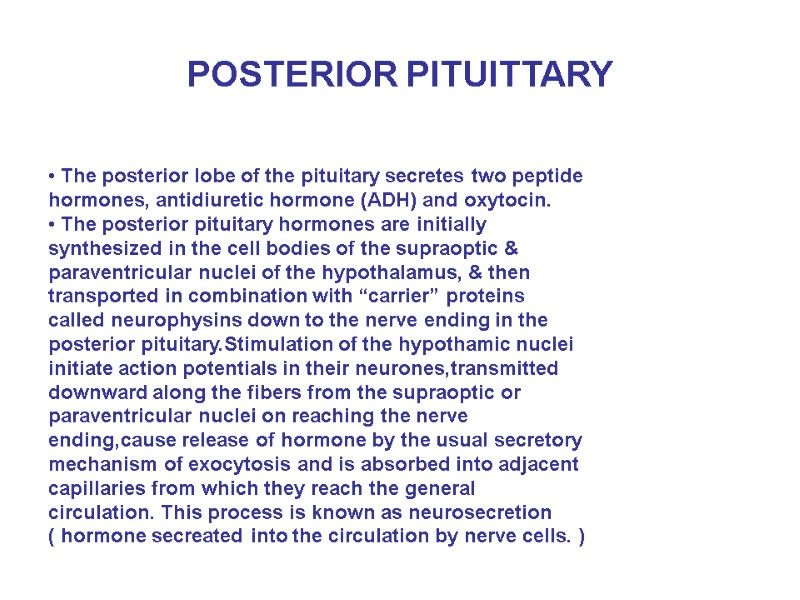
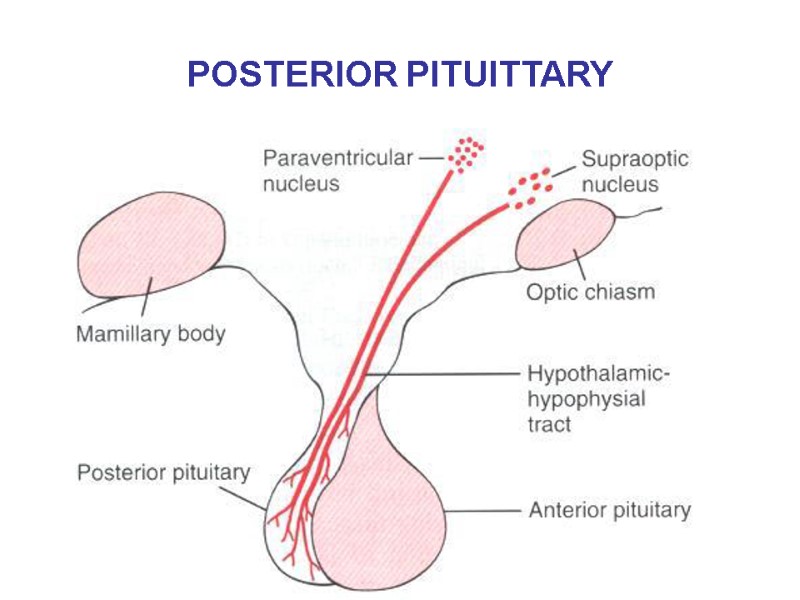
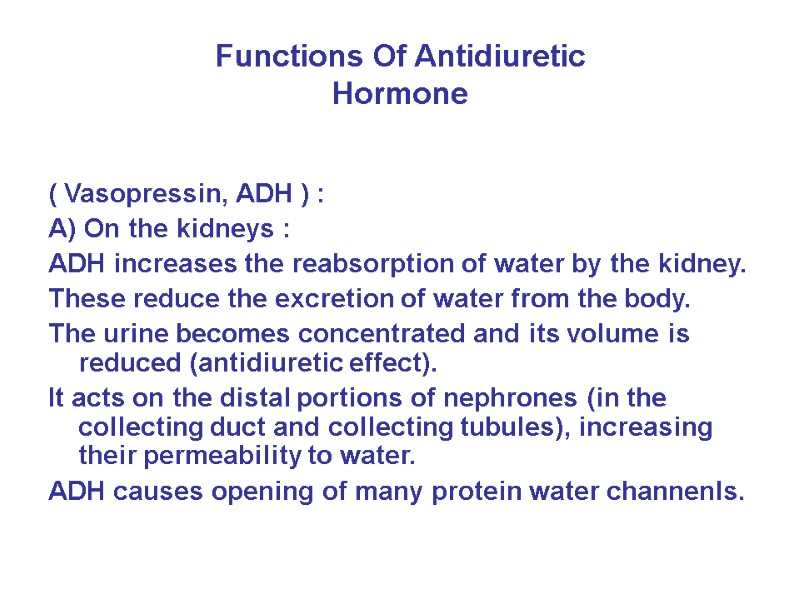
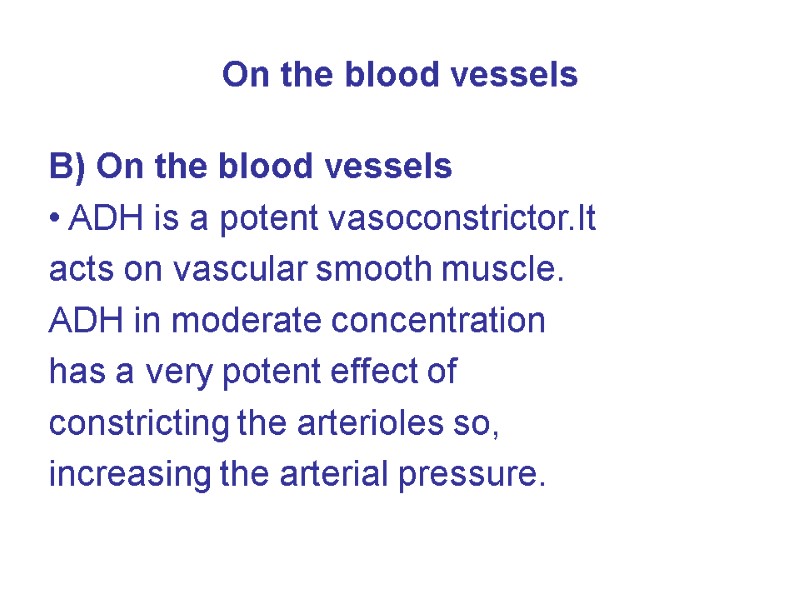
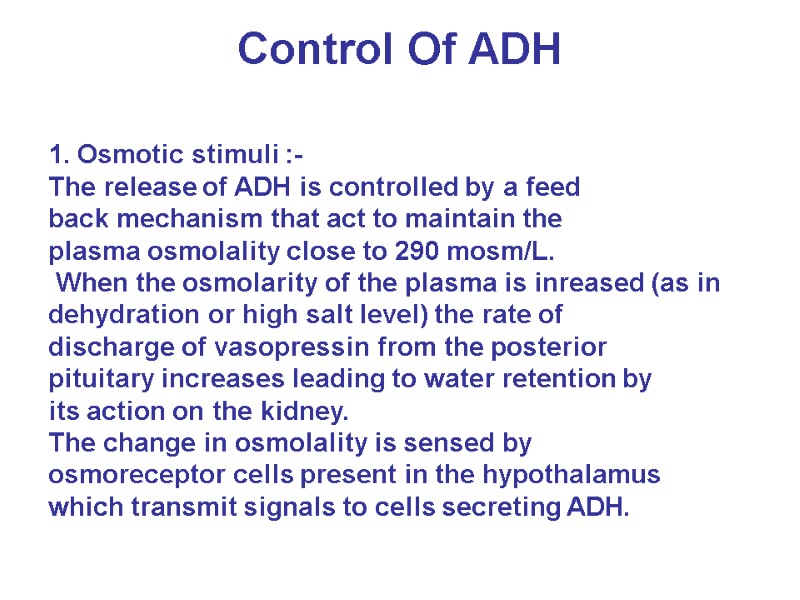
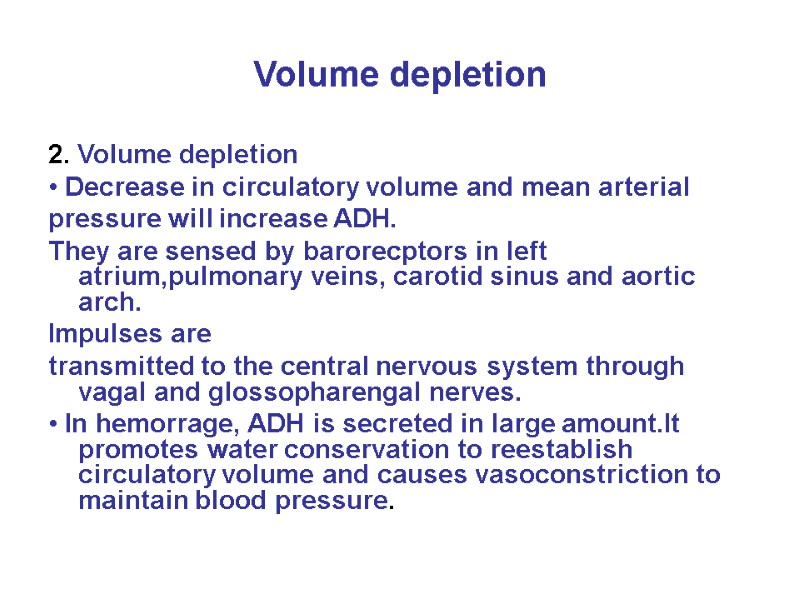
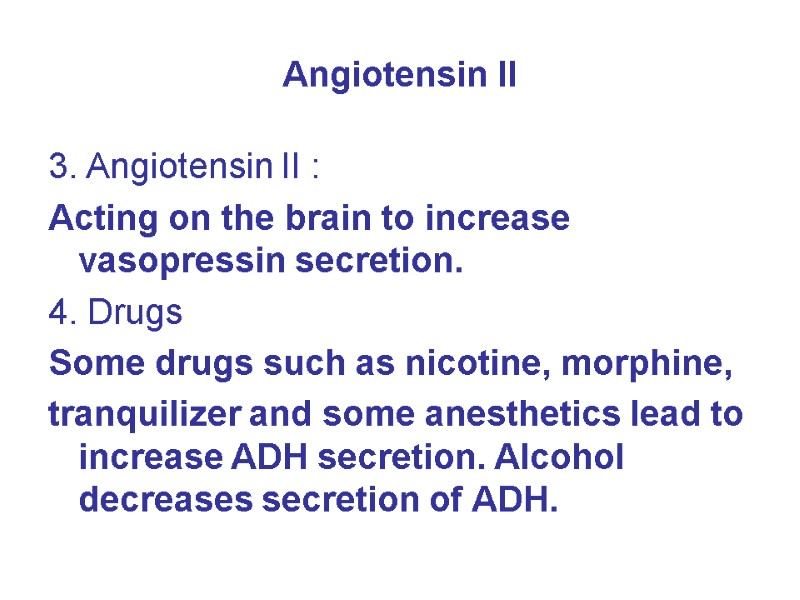
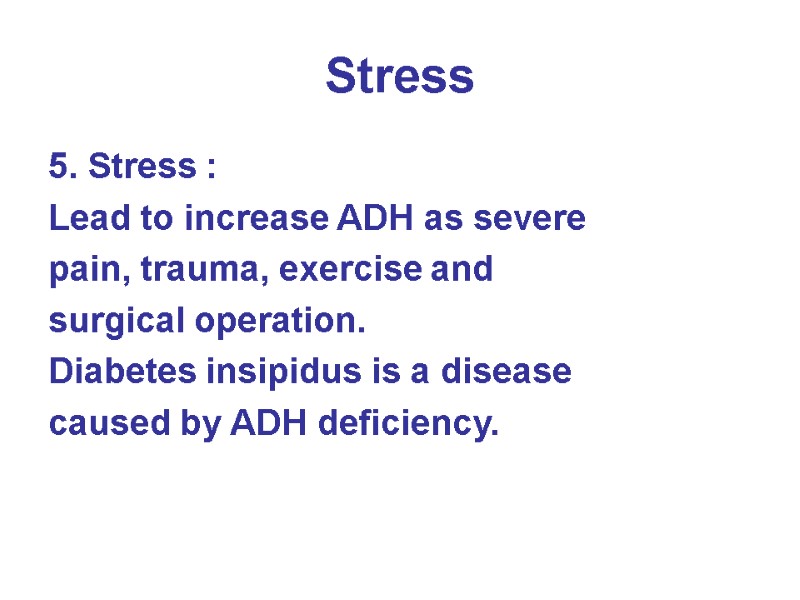
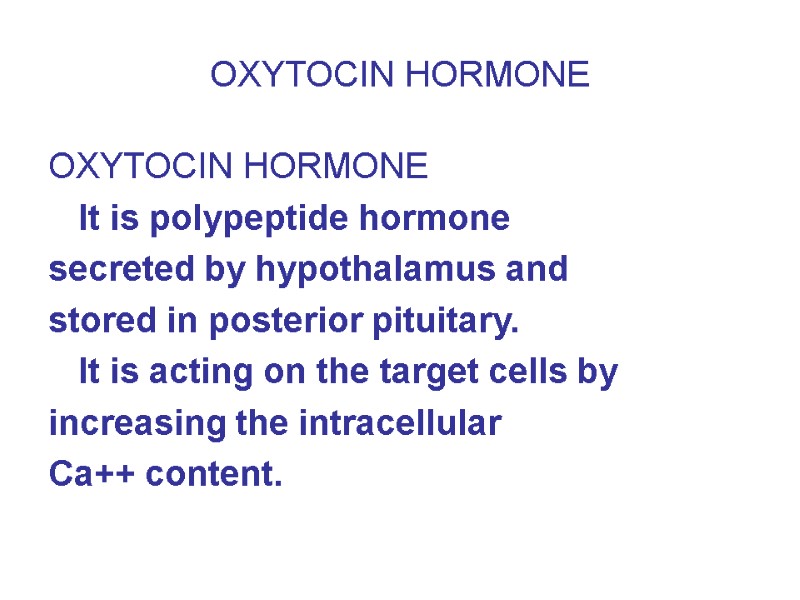
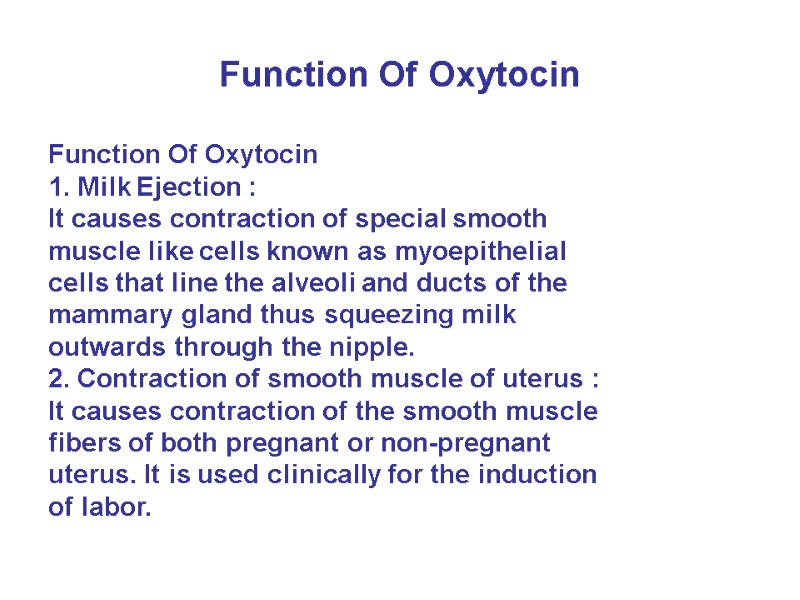
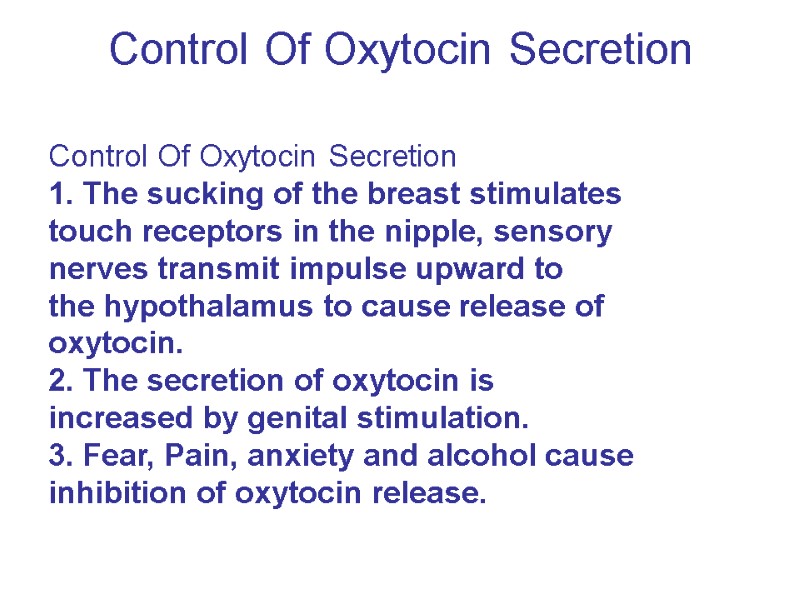
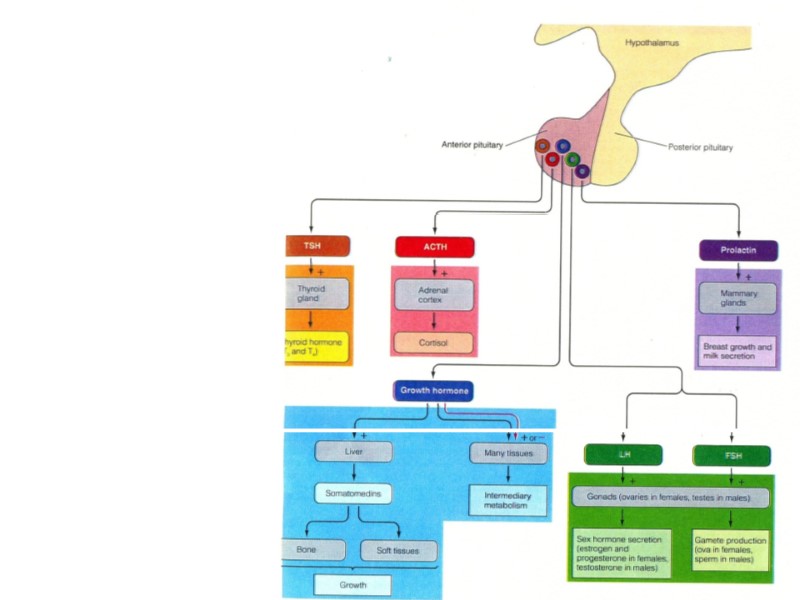
9538-endocrine_system.ppt
- Количество слайдов: 41
 ENDOCRINE SYSTEM Endorine system and nervous system are the two main control & integration system of the body. The two systems are linked through the hypothalamus. Hypothalamus controls secretion of many glands.
ENDOCRINE SYSTEM Endorine system and nervous system are the two main control & integration system of the body. The two systems are linked through the hypothalamus. Hypothalamus controls secretion of many glands.
 Nervous &Endocrine Systems inter-relation The nervous and the endocrine systems are inter-related in the hypothalamus through the: The hypothalamo-hypophyseal tract . The hypothalamo-hypopheseal –portal circulation .
Nervous &Endocrine Systems inter-relation The nervous and the endocrine systems are inter-related in the hypothalamus through the: The hypothalamo-hypophyseal tract . The hypothalamo-hypopheseal –portal circulation .
 Control of hormone secretion Nervous control : through the hypothalamus. 2- Freed back control : * -Ve feed back. * +Ve feed back.
Control of hormone secretion Nervous control : through the hypothalamus. 2- Freed back control : * -Ve feed back. * +Ve feed back.
 The Principle Endocrine Glands The Principle Endocrine Glands Are :- 1. Pituitary gland (anterior & posterior) 2. Thyroid gland. 3. Parathyroid gland. 4. Suprarenal or adrenal gland (cortex&medulla) 5. Islets of langerhans ( in the pancreas) 6. Male gonads ( testes) & Female gonads 7. Placenta.
The Principle Endocrine Glands The Principle Endocrine Glands Are :- 1. Pituitary gland (anterior & posterior) 2. Thyroid gland. 3. Parathyroid gland. 4. Suprarenal or adrenal gland (cortex&medulla) 5. Islets of langerhans ( in the pancreas) 6. Male gonads ( testes) & Female gonads 7. Placenta.
 Other Endocrine Organs :- 1. The kidney secrete : a) renin b) Erythropoietin, c)1.25 dihydroxy cholecalciferol, d) Certain Prostaglandin. 2. The Heart :Rt. Atrium secretes Atrial Natriuretic Peptide. 3. Local hormones secreted at :- GIT, -Chemical transmitters,released by nerve endings.
Other Endocrine Organs :- 1. The kidney secrete : a) renin b) Erythropoietin, c)1.25 dihydroxy cholecalciferol, d) Certain Prostaglandin. 2. The Heart :Rt. Atrium secretes Atrial Natriuretic Peptide. 3. Local hormones secreted at :- GIT, -Chemical transmitters,released by nerve endings.
 Hormones Are chemical substances sythesized & secreted by specific cells, they are transported by the circulation at very low concentration.It elicits a specific response in distant target tissues.
Hormones Are chemical substances sythesized & secreted by specific cells, they are transported by the circulation at very low concentration.It elicits a specific response in distant target tissues.
 Forms of Hormones in the Blood 1- Free. * It is not carried on a plasma protein . * It can bind directly to the receptors : active . * It is small in size , so can be filtered in urine . 2- protein bound . * Carried on plasma protein . * It acts as a reservoir. * It increases the half life of the hormone. * It is more soluble in plasma ( the lipid steroids , when bound to plasma proteins they are transformed into water soluble. * It is large in size , and so is not filtered in urine .
Forms of Hormones in the Blood 1- Free. * It is not carried on a plasma protein . * It can bind directly to the receptors : active . * It is small in size , so can be filtered in urine . 2- protein bound . * Carried on plasma protein . * It acts as a reservoir. * It increases the half life of the hormone. * It is more soluble in plasma ( the lipid steroids , when bound to plasma proteins they are transformed into water soluble. * It is large in size , and so is not filtered in urine .
 Hormone Transport & inactivation Water insoluble hormones : Steroid & thyroxin are bound to plasma proteins in blood stream. Only free hormones ( not in bound form ) can affect its target cells. Inactivation in liver by : degradation oxidation reduction methylation Conjugation to glucoronic acid Then excreted in : urine.
Hormone Transport & inactivation Water insoluble hormones : Steroid & thyroxin are bound to plasma proteins in blood stream. Only free hormones ( not in bound form ) can affect its target cells. Inactivation in liver by : degradation oxidation reduction methylation Conjugation to glucoronic acid Then excreted in : urine.
 Hormone Receptors &their activation Hormone Receptors &their activation: . Hormone never act directly. . They combine with Specific recaptors. . Receptors are large protein molecules, they are рresent either : On the surface of cells or inside the cells cytoplasm or in. nucleus.
Hormone Receptors &their activation Hormone Receptors &their activation: . Hormone never act directly. . They combine with Specific recaptors. . Receptors are large protein molecules, they are рresent either : On the surface of cells or inside the cells cytoplasm or in. nucleus.
 LOCATIONS Receptors of protein, peptide hormones&catecholamines located in the membrane. Receptors of steroid hormones located in cytoplasm. Receptors of thyroxin located in nucleus.
LOCATIONS Receptors of protein, peptide hormones&catecholamines located in the membrane. Receptors of steroid hormones located in cytoplasm. Receptors of thyroxin located in nucleus.
 Mechanism of action of hormones Mechanism of action of hormones which are protein in nature 1-On cell membrane of target cell.:hormone combines with its specific receptor. 2-This combination activates: adenyl cyclase protein enzyme which is also located in the membrane also, but a large portion of it protrudes in the cytoplasm. 3-The activated adenyl cyclase ATP convert into Cyclic AMP. 4-Cyclic AMP activates protein Kinases. 5-The activated protein catalyses phosphorelation of proteins and alter their functions. So few molecules of Activated adenyl cyclase in the cell membrane can cause man molecule of the next enzyme to be activated.
Mechanism of action of hormones Mechanism of action of hormones which are protein in nature 1-On cell membrane of target cell.:hormone combines with its specific receptor. 2-This combination activates: adenyl cyclase protein enzyme which is also located in the membrane also, but a large portion of it protrudes in the cytoplasm. 3-The activated adenyl cyclase ATP convert into Cyclic AMP. 4-Cyclic AMP activates protein Kinases. 5-The activated protein catalyses phosphorelation of proteins and alter their functions. So few molecules of Activated adenyl cyclase in the cell membrane can cause man molecule of the next enzyme to be activated.
 Effect of Hormones on the cells Effect of Hormones on the cells - Membrane Permeability changes. - Alteration of Enzyme Activity - ATP Cyclic AMP Protein Kinas Protein Synthesis - Gene activation - Initiate secretion - Causing muscle contraction or relaxation
Effect of Hormones on the cells Effect of Hormones on the cells - Membrane Permeability changes. - Alteration of Enzyme Activity - ATP Cyclic AMP Protein Kinas Protein Synthesis - Gene activation - Initiate secretion - Causing muscle contraction or relaxation
 Mechanism of action of Steroid Hormone That secreted by : adrenal cortex, ovaries & testes. 1) The steroid h. enters the cytoplasm of the cell where it binds with a specific receptor ( protein in nature). 2) The combined hormone receptor diffuse into the nucleus. 3) Then it activates the transcription process of specific genes to form a messenger RNA. 4) The messenger RNA diffuse to ‘ cytoplasm to promote synthesis of specific protein & enzymes within ribosomes’.
Mechanism of action of Steroid Hormone That secreted by : adrenal cortex, ovaries & testes. 1) The steroid h. enters the cytoplasm of the cell where it binds with a specific receptor ( protein in nature). 2) The combined hormone receptor diffuse into the nucleus. 3) Then it activates the transcription process of specific genes to form a messenger RNA. 4) The messenger RNA diffuse to ‘ cytoplasm to promote synthesis of specific protein & enzymes within ribosomes’.
 Action of thyroid hormones in cell nuclei Action of thyroid hormones in cell nuclei The hormone bind directly with receptors { protein in nature } inside nucleus itself. This combination activates genetic mechanism for formation of many enzymes that promote intra – celluler metabolic activity. Second messenger : Calmodulin : Some hormones combine with Membrane receptors leading to opening of Ca channels. Ca enter cell combine with protein called calmodulin leading to changes inside cell as : activation Of myosin kinase that act on smooth muscle myosin à contraction. Cyclic GMP: some h. combine with receptors activate guanyl cyclase enzyme leading toà formation of cyclic GMPà activate other enzymes inside cell.
Action of thyroid hormones in cell nuclei Action of thyroid hormones in cell nuclei The hormone bind directly with receptors { protein in nature } inside nucleus itself. This combination activates genetic mechanism for formation of many enzymes that promote intra – celluler metabolic activity. Second messenger : Calmodulin : Some hormones combine with Membrane receptors leading to opening of Ca channels. Ca enter cell combine with protein called calmodulin leading to changes inside cell as : activation Of myosin kinase that act on smooth muscle myosin à contraction. Cyclic GMP: some h. combine with receptors activate guanyl cyclase enzyme leading toà formation of cyclic GMPà activate other enzymes inside cell.
 Hypothalamic-hypophyseal connections • There are two types of connection between the hypothalamus and pituitary : • 1-Vascular connection between the hypothalamus and anterior Pituitary gland in the form of hypothalamic- hypophyseal portal circulation. • 2- nervous connection between hypothalamus and posterior Pituitary gland in form of hypothalamic-hypophyseal tract . • The hypothalamus receives signals from almost all sources in the nervous system,thus when a person is exposed to pain, a portion of the signals is transmitted to the hypothalamus that acts as a collecting center for internal body informations then Control secretion of pituitary glands .
Hypothalamic-hypophyseal connections • There are two types of connection between the hypothalamus and pituitary : • 1-Vascular connection between the hypothalamus and anterior Pituitary gland in the form of hypothalamic- hypophyseal portal circulation. • 2- nervous connection between hypothalamus and posterior Pituitary gland in form of hypothalamic-hypophyseal tract . • The hypothalamus receives signals from almost all sources in the nervous system,thus when a person is exposed to pain, a portion of the signals is transmitted to the hypothalamus that acts as a collecting center for internal body informations then Control secretion of pituitary glands .
 Control of anterior pituitary secretion by hypothalamus Control of anterior pituitary secretion by hypothalamus • There are neurohormones produced by the median eminence ofthe hypothalamus that regulate the functions of anterior pituitary. • These neurohormones diffuse into a primary plexus of capillaries and are transported down in large portal vessels in the pituitary stalk to a secondary set of capillaries in the anterior pituitary gland : it is called the hypophyseal portal system. • These neuro hormones comprise both releasing & inhibitory hormones. For each type of anterior pituitary hormone, there is a corresponding hypothalamic releasing hormone
Control of anterior pituitary secretion by hypothalamus Control of anterior pituitary secretion by hypothalamus • There are neurohormones produced by the median eminence ofthe hypothalamus that regulate the functions of anterior pituitary. • These neurohormones diffuse into a primary plexus of capillaries and are transported down in large portal vessels in the pituitary stalk to a secondary set of capillaries in the anterior pituitary gland : it is called the hypophyseal portal system. • These neuro hormones comprise both releasing & inhibitory hormones. For each type of anterior pituitary hormone, there is a corresponding hypothalamic releasing hormone
 Note • The anterior pituitary receives portal blood • The posterior pituitary receives arterial blood.
Note • The anterior pituitary receives portal blood • The posterior pituitary receives arterial blood.
 Actions of Ant. Pituitary H.
Actions of Ant. Pituitary H.
 Actions and Control of GH
Actions and Control of GH
 Growth Hormone • Somatotrophic H. = Somatotropin • It is formed of multiple amino acids. • It causes growth of all tissues. • It promotes both size and number of cells. • It promotes protein synthesis and deposition.
Growth Hormone • Somatotrophic H. = Somatotropin • It is formed of multiple amino acids. • It causes growth of all tissues. • It promotes both size and number of cells. • It promotes protein synthesis and deposition.
 Metabolic effects of Growth Hormone A) Growth h. increases protein synthesis : Increase transport of amino acid through cell wall. Increase protein synthesis by ribosome. Stimulates nucleus for formation of RNA. It decreases protein catabolism (I.e.protein sparer) B) Effect on fats is: it has a lipolytic effect: To give energy. C) Effect on CHO: It has diabetogenic effect – Decrease glucose utilization – Increase glycogen deposition. – Decrease number of insulin receptors. – Decrease glucose uptake by the cells
Metabolic effects of Growth Hormone A) Growth h. increases protein synthesis : Increase transport of amino acid through cell wall. Increase protein synthesis by ribosome. Stimulates nucleus for formation of RNA. It decreases protein catabolism (I.e.protein sparer) B) Effect on fats is: it has a lipolytic effect: To give energy. C) Effect on CHO: It has diabetogenic effect – Decrease glucose utilization – Increase glycogen deposition. – Decrease number of insulin receptors. – Decrease glucose uptake by the cells
 Other Effects of Growth H Other Effects of Growth H. : • Stimulates Erythropoiesis. • Increase Ca+ + absorption at GIT & produce phosphate balance. • Decrease urinary excretion of Na+, K+: both needed for growth of tissues.
Other Effects of Growth H Other Effects of Growth H. : • Stimulates Erythropoiesis. • Increase Ca+ + absorption at GIT & produce phosphate balance. • Decrease urinary excretion of Na+, K+: both needed for growth of tissues.
 Regulation Of Growth H. Secretion • A) Hypothalamic control :1- G H R H & Somatostatin H. (G H I H ) • Mainly by negative Feed - Back Control • Somatostatin produced by : hypothalamus and delta cell of islets of langerhans of pancreas Somatostatin inhibits secretion of : Growth Hormone,insulin glucagon. 2-IGFs:it is produced by the liver, it decrease G H secretion by direct inhibition of pituitary& ↑somatostatin. 3-Ghrelin H, secreted by stomach→ ↑G H + ↑appetite.
Regulation Of Growth H. Secretion • A) Hypothalamic control :1- G H R H & Somatostatin H. (G H I H ) • Mainly by negative Feed - Back Control • Somatostatin produced by : hypothalamus and delta cell of islets of langerhans of pancreas Somatostatin inhibits secretion of : Growth Hormone,insulin glucagon. 2-IGFs:it is produced by the liver, it decrease G H secretion by direct inhibition of pituitary& ↑somatostatin. 3-Ghrelin H, secreted by stomach→ ↑G H + ↑appetite.
 Stimuli that increase GH secretion B) Stimuli that increase GH secretion : • Hypoglycemia decrease level of cell protein. • increase conc. Of fatty acids in blood. • Deep sleep. • Exercise, emotions, stress. • Growth Hormone level has diurnal variation.
Stimuli that increase GH secretion B) Stimuli that increase GH secretion : • Hypoglycemia decrease level of cell protein. • increase conc. Of fatty acids in blood. • Deep sleep. • Exercise, emotions, stress. • Growth Hormone level has diurnal variation.
 Effect of sleep & exercise on GH secretion
Effect of sleep & exercise on GH secretion

 Growth hormone exerts its effects on bones through somatomedins Growth hormone exerts its effects on bones through somatomedins • Growth hormone causes the liver to form somatomedins that stongly increase all aspects of bone growth as: stimulation of osteoblasts, increased protein deposition by chondrocytic & osteogenic cells . Effects of somatomedins on growth are similar to that of insulin so it is called Insulin like growth factors( IGFs).It cause increase glucose &amino acids uptake by the cells. It also decrease lipolysis.
Growth hormone exerts its effects on bones through somatomedins Growth hormone exerts its effects on bones through somatomedins • Growth hormone causes the liver to form somatomedins that stongly increase all aspects of bone growth as: stimulation of osteoblasts, increased protein deposition by chondrocytic & osteogenic cells . Effects of somatomedins on growth are similar to that of insulin so it is called Insulin like growth factors( IGFs).It cause increase glucose &amino acids uptake by the cells. It also decrease lipolysis.
 Prolactin • Secreted by anterior Pituitary. • Function : • Stimulation. Of milk secretion by mammary gland. • Stimulation Of synthesis. Of fat & lactose mammary gland. • Inhibit the action Of gonadoropin à inhibition of ovulation amenorrhea & lactation. • In males : unknown functions:-- • If excess Prolactin à impotence. • Regulation of Secretion : Prolactin Releasing H. From hypothalamus and Prolactin inhibitory H.(dopamine)
Prolactin • Secreted by anterior Pituitary. • Function : • Stimulation. Of milk secretion by mammary gland. • Stimulation Of synthesis. Of fat & lactose mammary gland. • Inhibit the action Of gonadoropin à inhibition of ovulation amenorrhea & lactation. • In males : unknown functions:-- • If excess Prolactin à impotence. • Regulation of Secretion : Prolactin Releasing H. From hypothalamus and Prolactin inhibitory H.(dopamine)
 Prolactin 1. Normally Prolactin inhibitory H. Predominates or overbalances the effect of PRH. 2. Prolactin Facilitated PIH from hypothalamus. = negative feed-back mechanism to inhibit its own secret. 3. increase secret. Of Prolactin in : exercise stress suckling sleep. . Tumour of cells : Excessive secretion : - Galactorrhea. - Amenorrhea. - Impotence in males.
Prolactin 1. Normally Prolactin inhibitory H. Predominates or overbalances the effect of PRH. 2. Prolactin Facilitated PIH from hypothalamus. = negative feed-back mechanism to inhibit its own secret. 3. increase secret. Of Prolactin in : exercise stress suckling sleep. . Tumour of cells : Excessive secretion : - Galactorrhea. - Amenorrhea. - Impotence in males.
 POSTERIOR PITUITTARY • The posterior lobe of the pituitary secretes two peptide hormones, antidiuretic hormone (ADH) and oxytocin. • The posterior pituitary hormones are initially synthesized in the cell bodies of the supraoptic & paraventricular nuclei of the hypothalamus, & then transported in combination with “carrier” proteins called neurophysins down to the nerve ending in the posterior pituitary.Stimulation of the hypothamic nuclei initiate action potentials in their neurones,transmitted downward along the fibers from the supraoptic or paraventricular nuclei on reaching the nerve ending,cause release of hormone by the usual secretory mechanism of exocytosis and is absorbed into adjacent capillaries from which they reach the general circulation. This process is known as neurosecretion ( hormone secreated into the circulation by nerve cells. )
POSTERIOR PITUITTARY • The posterior lobe of the pituitary secretes two peptide hormones, antidiuretic hormone (ADH) and oxytocin. • The posterior pituitary hormones are initially synthesized in the cell bodies of the supraoptic & paraventricular nuclei of the hypothalamus, & then transported in combination with “carrier” proteins called neurophysins down to the nerve ending in the posterior pituitary.Stimulation of the hypothamic nuclei initiate action potentials in their neurones,transmitted downward along the fibers from the supraoptic or paraventricular nuclei on reaching the nerve ending,cause release of hormone by the usual secretory mechanism of exocytosis and is absorbed into adjacent capillaries from which they reach the general circulation. This process is known as neurosecretion ( hormone secreated into the circulation by nerve cells. )
 POSTERIOR PITUITTARY
POSTERIOR PITUITTARY
 Functions Of Antidiuretic Hormone ( Vasopressin, ADH ) : A) On the kidneys : ADH increases the reabsorption of water by the kidney. These reduce the excretion of water from the body. The urine becomes concentrated and its volume is reduced (antidiuretic effect). It acts on the distal portions of nephrones (in the collecting duct and collecting tubules), increasing their permeability to water. ADH causes opening of many protein water channenls.
Functions Of Antidiuretic Hormone ( Vasopressin, ADH ) : A) On the kidneys : ADH increases the reabsorption of water by the kidney. These reduce the excretion of water from the body. The urine becomes concentrated and its volume is reduced (antidiuretic effect). It acts on the distal portions of nephrones (in the collecting duct and collecting tubules), increasing their permeability to water. ADH causes opening of many protein water channenls.
 On the blood vessels B) On the blood vessels • ADH is a potent vasoconstrictor.It acts on vascular smooth muscle. ADH in moderate concentration has a very potent effect of constricting the arterioles so, increasing the arterial pressure.
On the blood vessels B) On the blood vessels • ADH is a potent vasoconstrictor.It acts on vascular smooth muscle. ADH in moderate concentration has a very potent effect of constricting the arterioles so, increasing the arterial pressure.
 Control Of ADH 1. Osmotic stimuli :- The release of ADH is controlled by a feed back mechanism that act to maintain the plasma osmolality close to 290 mosm/L. When the osmolarity of the plasma is inreased (as in dehydration or high salt level) the rate of discharge of vasopressin from the posterior pituitary increases leading to water retention by its action on the kidney. The change in osmolality is sensed by osmoreceptor cells present in the hypothalamus which transmit signals to cells secreting ADH.
Control Of ADH 1. Osmotic stimuli :- The release of ADH is controlled by a feed back mechanism that act to maintain the plasma osmolality close to 290 mosm/L. When the osmolarity of the plasma is inreased (as in dehydration or high salt level) the rate of discharge of vasopressin from the posterior pituitary increases leading to water retention by its action on the kidney. The change in osmolality is sensed by osmoreceptor cells present in the hypothalamus which transmit signals to cells secreting ADH.
 Volume depletion 2. Volume depletion • Decrease in circulatory volume and mean arterial pressure will increase ADH. They are sensed by barorecptors in left atrium,pulmonary veins, carotid sinus and aortic arch. Impulses are transmitted to the central nervous system through vagal and glossopharengal nerves. • In hemorrage, ADH is secreted in large amount.It promotes water conservation to reestablish circulatory volume and causes vasoconstriction to maintain blood pressure.
Volume depletion 2. Volume depletion • Decrease in circulatory volume and mean arterial pressure will increase ADH. They are sensed by barorecptors in left atrium,pulmonary veins, carotid sinus and aortic arch. Impulses are transmitted to the central nervous system through vagal and glossopharengal nerves. • In hemorrage, ADH is secreted in large amount.It promotes water conservation to reestablish circulatory volume and causes vasoconstriction to maintain blood pressure.
 Angiotensin II 3. Angiotensin II : Acting on the brain to increase vasopressin secretion. 4. Drugs Some drugs such as nicotine, morphine, tranquilizer and some anesthetics lead to increase ADH secretion. Alcohol decreases secretion of ADH.
Angiotensin II 3. Angiotensin II : Acting on the brain to increase vasopressin secretion. 4. Drugs Some drugs such as nicotine, morphine, tranquilizer and some anesthetics lead to increase ADH secretion. Alcohol decreases secretion of ADH.
 Stress 5. Stress : Lead to increase ADH as severe pain, trauma, exercise and surgical operation. Diabetes insipidus is a disease caused by ADH deficiency.
Stress 5. Stress : Lead to increase ADH as severe pain, trauma, exercise and surgical operation. Diabetes insipidus is a disease caused by ADH deficiency.
 OXYTOCIN HORMONE OXYTOCIN HORMONE It is polypeptide hormone secreted by hypothalamus and stored in posterior pituitary. It is acting on the target cells by increasing the intracellular Ca++ content.
OXYTOCIN HORMONE OXYTOCIN HORMONE It is polypeptide hormone secreted by hypothalamus and stored in posterior pituitary. It is acting on the target cells by increasing the intracellular Ca++ content.
 Function Of Oxytocin Function Of Oxytocin 1. Milk Ejection : It causes contraction of special smooth muscle like cells known as myoepithelial cells that line the alveoli and ducts of the mammary gland thus squeezing milk outwards through the nipple. 2. Contraction of smooth muscle of uterus : It causes contraction of the smooth muscle fibers of both pregnant or non-pregnant uterus. It is used clinically for the induction of labor.
Function Of Oxytocin Function Of Oxytocin 1. Milk Ejection : It causes contraction of special smooth muscle like cells known as myoepithelial cells that line the alveoli and ducts of the mammary gland thus squeezing milk outwards through the nipple. 2. Contraction of smooth muscle of uterus : It causes contraction of the smooth muscle fibers of both pregnant or non-pregnant uterus. It is used clinically for the induction of labor.
 Control Of Oxytocin Secretion Control Of Oxytocin Secretion 1. The sucking of the breast stimulates touch receptors in the nipple, sensory nerves transmit impulse upward to the hypothalamus to cause release of oxytocin. 2. The secretion of oxytocin is increased by genital stimulation. 3. Fear, Pain, anxiety and alcohol cause inhibition of oxytocin release.
Control Of Oxytocin Secretion Control Of Oxytocin Secretion 1. The sucking of the breast stimulates touch receptors in the nipple, sensory nerves transmit impulse upward to the hypothalamus to cause release of oxytocin. 2. The secretion of oxytocin is increased by genital stimulation. 3. Fear, Pain, anxiety and alcohol cause inhibition of oxytocin release.

